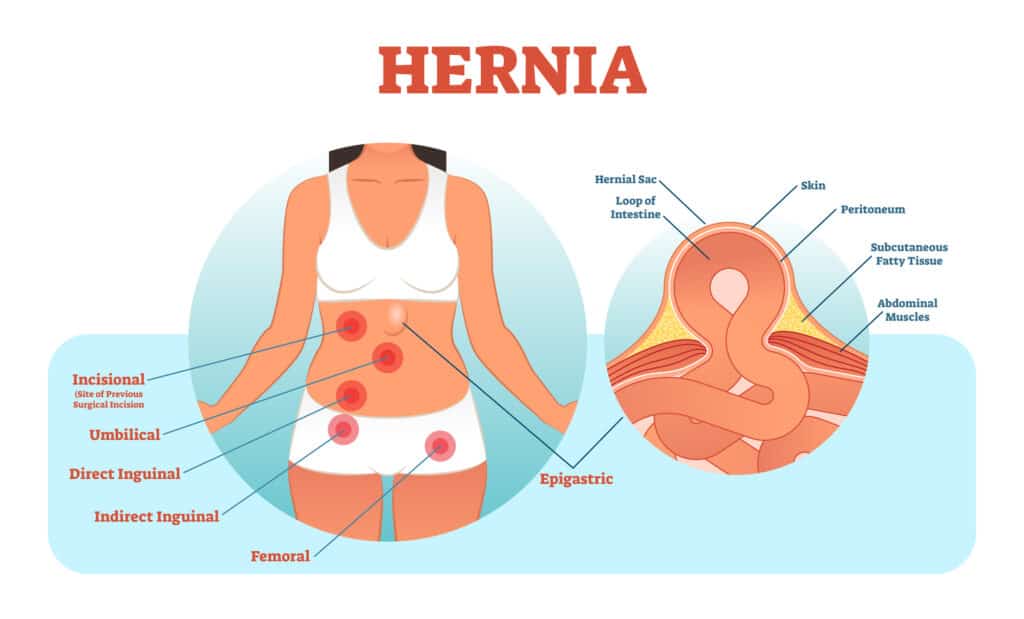
Are you worried about developing a pelvic hernia?
Do you have persistent pelvic floor discomfort – or have you been told that a hernia may cause pelvic pain, yet you don't know what that means?
If so, then this blog post is for you. It's natural to feel concerned when you hear about unfamiliar medical conditions, especially when you think you might be at risk. But there’s no need to feel overwhelmed.
Here at Nancy Branberg Physical Therapy, our mission is to help bring clarity and answer all your questions about women's health, so you can understand precisely what's happening in your body.
Although pelvic hernias can be painful and uncomfortable, there are ways to manage the pain and reduce discomfort.
Physical therapy is one option that can help alleviate the symptoms of pelvic hernia. In this article, we discuss the causes and symptoms of pelvic hernias and how to treat them. We discuss what a pelvic floor hernia is, how it can affect your life, and what you can do to fix it.
More Blogs From Nancy Branberg
What Are The Symptoms Of Pelvic Inflammatory Disease?
Hypertonic Pelvic Floor: Symptoms, Causes & Treatment
What Are Kegel Exercises, And Should I Be Doing Them?
What Is A Pelvic Hernia, And How Can It Affect Your Health?

So, you’ve probably heard the term “hernia” before, but do you know what a pelvic hernia actually is?
Pelvic floor hernias can have serious implications on your quality of life, so it is important to be proactive regarding this condition.
Ultimately, being mindful of your body and understanding the potential health concerns associated with pelvic floor hernias like stress incontinence is essential.
A pelvic hernia is when an organ or tissue in your lower abdominal area bulges into the pelvic region. This bulging can happen due to weakened muscles in the pelvic area, typically from aging, chronic constipation, or childbirth.
They can also occur because of obesity, pregnancy, injuries, or previous surgeries.
While not as common as other types of hernias, pelvic hernias can cause discomfort, pain, and in rare cases, even complications like intestinal obstruction or strangulation.
You may also see bulging or swelling in the pelvic area, have problems with urinating and bowel movements, and sometimes nausea and vomiting.
So, if you think you have a pelvic hernia, it's important to get a professional evaluation of your symptoms from a pelvic floor specialist.
It's worth pointing out that if you have a pelvic hernia, delaying medical attention can cause the hernia to worsen and potentially require more invasive treatment, like surgery.
When diagnosing pelvic hernias, we can usually diagnose using a physical exam alone. Still, you may require imaging tests to confirm the diagnosis.
There are different types of pelvic hernias; the most common include:
This is the most common type of pelvic hernia. They occur when the bowel enters the “inguinal canal” at the groin area.
The symptoms of an inguinal hernia can include pain when you cough or pain/discomfort when you lift heavy objects or bend forwards. You may also feel dragging, heaviness, or pressure in or around your groin area.
Surgery is usually the only way to repair this type of hernia completely. Still, physical therapy can prevent the development of these hernias and help minimize the symptoms.

Femoral hernia:
These hernias are less common but can also occur in the upper thigh and groin – due to the bowel bulging into the "femoral canal."
If you have a femoral hernia, you'll likely have a sore lump in the upper thigh or groin that goes away when you lie down. Symptoms can be improved with physical therapy, but surgical repair is usually required.
This type of pelvic hernia happens when the bowel pushes through the “obturator foramen” in the pelvic bone.
The symptoms include abdominal pain, nausea, vomiting, constipation, and bowel obstruction. This type of hernia often requires surgery to fix.
Some risk factors can increase your risk of developing a pelvic hernia. They include:
Age: As we age, the body's muscles weaken, which can increase your risk of developing a pelvic hernia.
Genetic disposition: Having a relative, like a parent or sibling, who has had a hernia can put you at a higher risk of developing one.
Chronic coughing: If you have another medical condition that causes chronic coughing, you are more likely to develop a pelvic hernia.
Constipation: Repeated straining due to constipation can increase your risk of a pelvic hernia.
Previous hernia: If you’ve had a hernia in the past, your risk of developing another hernia is slightly higher than average.
How Does Pelvic Floor Therapy Help With Pelvic Hernia?

One of the most effective treatments for pelvic hernias is a special type of physical therapy called Pelvic Floor Therapy.
This form of physical therapy focuses on strengthening the muscles and tissues in your lower pelvis to improve issues such as bladder control, pain relief, and other problems associated with pelvic hernias.
At its core, pelvic floor therapy aims to provide relief by helping to keep your abdominal organs in place and preventing organ prolapse or them from sliding out of position. But what exactly is it, and how can it help pelvic hernias?
Well, pelvic floor therapy is an approach to treatment that targets the pelvic floor muscles to improve function and resolve a wide range of conditions that can affect the organs, muscles, and connective tissues in and around the pelvic region.
It is a non-surgical intervention effective for pelvic pain, urinary incontinence, and even pelvic organ prolapse. Pelvic floor therapy can help if you experience uncomfortable symptoms such as urinary incontinence, constipation, pelvic pain, or pain during intercourse.
So, if you have a pelvic hernia or any other condition affecting the pelvic region, why not try pelvic floor therapy?
Using a range of techniques, we help strengthen your pelvic floor muscles, supporting the hernia and reducing the associated symptoms.
Through a series of therapeutic exercises, we help restore strength, flexibility, and coordination to the muscles in the pelvic floor, which ultimately reduces the severity of symptoms and improves your quality of life.
These exercises can range from simple Kegel exercises to more advanced movements that we tailor to your individual needs.
Our techniques may include biofeedback, electrical stimulation, or manual joint and soft tissue manipulation. With a commitment to the therapy, you can expect improvements in your bladder and bowel control, less pain during sex, and increased confidence in everyday activities.
Pelvic floor therapy is a safe, non-invasive method to reduce discomfort related to a pelvic hernia and a preventative measure for those at higher risk of developing one.
It includes techniques such as massaging the muscles of the pelvic floor, performing strengthening or stretching exercises, and applying gentle pressure on painful areas.
You can also support your body's natural healing process and speed up your recovery by consuming a diet rich in fiber, lean proteins, healthy fats, and plenty of fruits and vegetables.
So, if you're undergoing pelvic floor therapy, consider making some dietary changes to complement your treatment.
You may be surprised at how much of a difference it can make. Additionally, maintaining positive mental health habits can support the long-lasting results of pelvic floor therapy.
To learn more about how pelvic floor therapy can help, you can book a Free Discovery Visit to come and see us at our women’s health clinic in Falls Church, VA, and chat with us about your pelvic floor issues.
How To Prevent A Pelvic Hernia

If you’ve been told that you’re at risk for developing a pelvic hernia, don’t worry - there are some things you can do to help prevent it.
It all starts with taking care of yourself. Maintaining a healthy weight, avoiding heavy lifting, straining, and not smoking are all reasonable steps.
A healthy, balanced diet can help keep your weight in check, taking some pressure off your pelvic area.
Regular exercise – especially exercises that strengthen your core muscles – can help support your pelvic floor.
You'll also want to ensure that you're staying as active as possible and doing exercises that strengthen the muscles in your pelvic area.
These key steps can make a big difference in reducing your risk of developing a pelvic hernia. But it's important to remember that pelvic hernias can occur in anyone and significantly impact your lifestyle and quality of life.
If you're looking to strengthen your pelvic floor, there are a few exercises that you can do at home that can help.
Kegels, for example, involve contracting and releasing the muscles that control urine flow and can be done anywhere, anytime.
Squats and lunges can also help activate the pelvic floor muscles while simultaneously working for other muscle groups.
It's also important to avoid straining during bowel movements and to maintain a healthy weight to reduce the risk of hernias.


